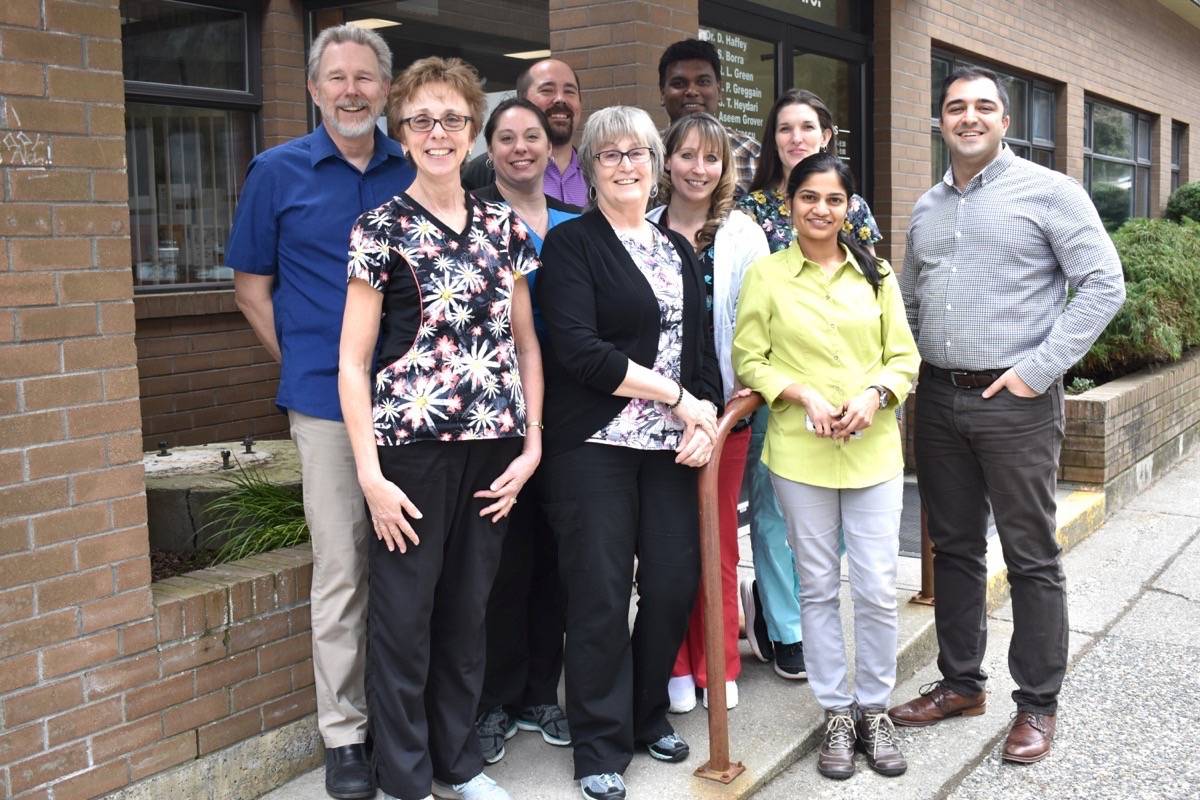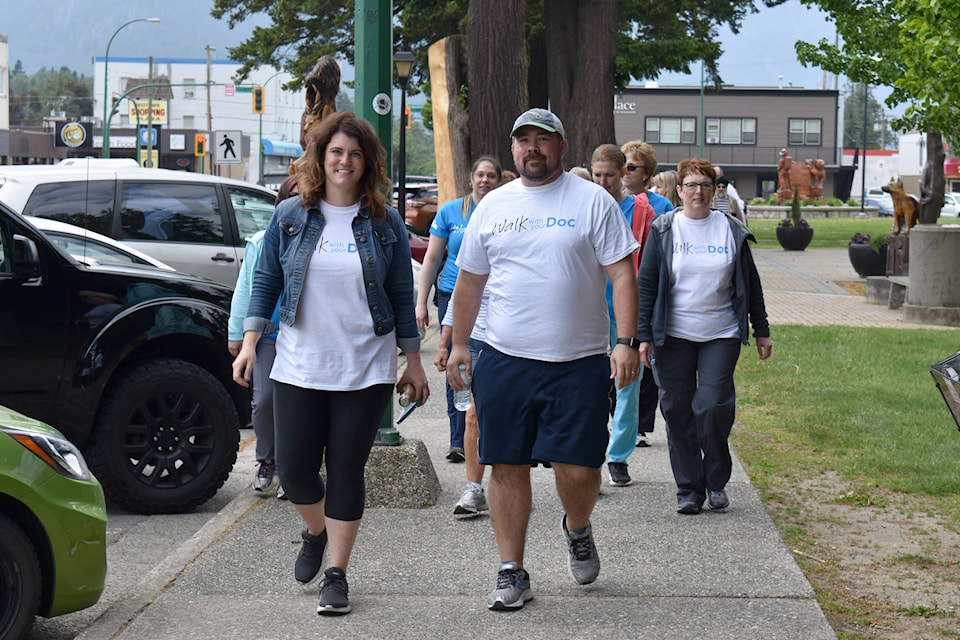With rural communities facing shortages as doctors retire without anyone to take their place, Hope has found a formula where not only are doctors coming here and staying here, they are also expanding their services up the Fraser Canyon.
What a study in the Canadian Medical Association Journal (CMAJ) identified as a grave problem in December 2017, doctors retiring earlier in rural communities leading to a doctor shortage in these areas, was something Hope faced in 2013. Since then, the local medical community has worked hard to attract and retain doctors, which has seen success as the community now has a large group of doctors and registered nurses who are now expanding their services to Boston Bar, Spuzzum and Boothroyd.
Leading the charge is Dr. Joshua Greggain, a family doctor in Hope since 2004 and site medical director for the Fraser Canyon Hospital. Greggain sees it as his responsibility to showcase what Hope has to offer to physicians: the ability to practice a full spectrum of medicine, work alongside a community of medical professionals and have a life outside of work.
“It is our responsibility as the people who’ve been here the longest, to go and tout that to other people, whether that be through conversation and relationship with other people or teaching,” he said.
Addressing a crisis in 2013
Today, the community has gone from five doctors to eight full time and two part-time physicians as well as another physician who works out of the hospital and three nurse practitioners. This is a stark contrast to 2013 when Greggain declared Hope in crisis after three medical clinics closed down within a span of two years.
To address the crisis, Greggain proposed a novel approach to providing primary care in Hope: ‘comprehensive, collaborative care’ where patients could go between the various medical providers in town —the Fraser Canyon Hospital, the walk-in clinic, the medical clinic, residential care facilities —while being supported by physicians along the way, who knew their medical situation and knew them. At the centre of this approach, Greggain identified the need to recruit and retain local family physicians.
The December CMAJ study, Patterns of physician retirement and pre-retirement activity: a population-based cohort study, identified recruiting and retaining doctors as a difficulty in many rural areas. This, coupled with rural doctors retiring early and the over 40 per cent of B.C. doctors at or nearing retirement age, spells bad news for rural communities.
“A smaller rural physician workforce could see increased rates of burnout and deterioration in the ability of those physicians to achieve work-life balance, while also exacerbating access issues for the residents of those communities,” the study stated.
While these statistics were hitting the news in 2017, Greggain was busy making progress on the plan he had enacted four years earlier. And it was bearing fruit.
Bringing doctors to Hope early in their career
The Hope Medical Clinic brings in five to six interns each year, in one or two month blocks, careful not to bring them in over the holidays or during the summer as work-life balance is important.
Greggain allows these students to see the joys and benefits of being able to provide a full-spectrum of care, and he does so early.
“Part of it is trying to get them at an influential stage in their career to say ‘Hey, I want the ability to be able to see a patient in a trauma and then deal with a patient with a heart attack or a pulmonary embolism or all these other things’…they want to be able to have a full-service practice. And so by inspiring them at that phase, then they get drawn back to here,” he said.
Exposing doctors to Hope early in their career is very important, as one of the three main predictors of success in rural communities is having a good experience there. The other two, Greggain explained, are being from the community or having a spouse from the community.
‘Walking a journey through patients’ lives’
Doctors here get to follow their patients from the clinic, to the emergency room, to hospital stays and back to the clinic. This ability to follow through, Greggain refers to it as ‘walking a journey through patients’ lives’, is a fulfilling part of rural family medicine which doctors practicing in urban areas rarely get to experience.
“Practicing this kind of medicine that is really quite fulfilling — emergency medicine, family practice, hospital, hospice, residential care and everything in between,” he said. “We get to have a continuity of care that transcends what urban physicians are pigeonholed to go do, and for me that is quite satisfying.”
Young doctors also get exposed to smaller and predominantly First Nations communities, through clinics in Boston Bar, Spuzzum and Boothroyd. This influences their practice, whether they decide to stay rural or go back to their home communities.
“They start to look at ‘how can I do things differently in my practice life, how can I address and evaluate the needs of a particular community?’ If we can offer people the opportunity to look and see what kind of needs a particular population is or needs, we can help them adapt to that environment,” Greggain said.
Really knowing the intimate details about your patients and their lives challenge at times, Greggain said, as you could spend all your time catching up with patients and how their families are, then remember your role as a care provider first.
This is also why about 50 per cent of the medical team choose to live outside of the community, to maintain that balance.
Living the work-life balance
Another benefit of rural practice is the ability to have a work-life balance, which looks quite different from the overworked sleep-deprived caricatures the public may be used to watching on long-running TV series.
“Historically, physicians would work very hard and would compromise or sacrifice other elements to their life, whether it be family or personal health,” Greggain said. “By giving a younger generation of physicians the opportunity to balance that out, it both makes for happier, healthier practitioners, but it also then makes for ultimately better patient care.”
In a business where a mistake can cost a life or lead to life-threatening medical conditions, ensuring a physician has a good work-life balance can be life-saving.
Greggain said he models this himself and with his team, by tending to his own personal life.
“Suddenly that says to the next generation of physicians ‘this group actually helps each other out, backs each other up and when I’m not here suddenly I have the ability to beat my daughter’s dance recital or I can take a day off and go to my mother-in-law’s 50th birthday party’,” he explained. “As you pattern the behaviours you want to generate, suddenly people become attracted to that.”
The team environment is also important: the clinic has had five doctors arrive within the past two years and Greggain said the team works to make them feel included, ensures they have a place to stay, have their personal financial needs looked after and have social connections to their workplace.
“The connection to your workplace as a community, as a second family is as important as the actual work,” Greggain said, adding physicians across Canada work an average of 60 to 65 hours a week.
Expanding beyond Hope
Not only is this process working, it’s now flourishing to the point where Greggain said his team is now looking outside Hope and outside the medical field.
Within Hope, he said getting a family doctor within a few weeks of moving here is a possibility. Specialists are brought to the Fraser Canyon Clinic, so patients don’t have to leave the community.
Some physicians and nurse practitioners within the community are also specializing, for example in working with geriatric patients, youth mental health or responding to the opioid crisis by developing methadone and suboxone partnerships.
The physicians have expanded beyond Hope, visiting Boston Bar on Wednesdays, and Boothroyd and Spuzzum twice a month in each community.
A lot of this work involves other service providers —Boston Bar has a physician, a nurse practitioner, mental health worker and employment officer at the weekly visit. The idea is patients don’t always need a doctor, often the need revolves around food security, lifestyle management, mental health or other considerations.
Greggain said work is also ongoing to support Agassiz and Seabird, communities that haven’t had as much success as Hope attracting physicians.
See related coverage:
Going above and beyond the call of duty for one local doctor
Is there more to this story?
news@hopestandard.com
Like us on Facebook and follow us on Twitter

